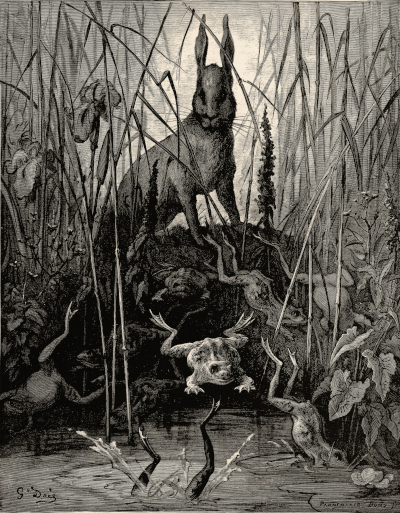Jean de La Fontaine was a famous 17th century French poet whose literature would inspire a series of drawings by Gustave Doré in 1867.
The series was known as The Fables of La Fontaine and the French illustrator would complete 8 large and 250 small plates for this commission. The items would then be engraved and printed, with the publication released by Hachette and Co. which was based in Paris. The Hare and the Frogs is one of the most famous passages from the entire series and focuses on the timid nature of hares. Within this drawing we find a hare stood up, looking over a number of frogs who hurtle towards the safety of a pond. Reeds stick up vertically within this composition to set the scene, whilst one frog's legs appear from the water in an almost comical image. A bright light appears from behind the hare, which itself looks particularly large in comparison to the other creatures within this scene. The story therefore tells of how the hares realised that others were living in fear even more so than them, and that they should be more grateful about their own situation.
The fable itself is believed to have come from the Middle Ages, with Jean de La Fontaine collecting and publishing many of these together within his wide selection. Some were more recent than this however, but we believe that The Hare and the Frogs came from Aesop's Fables, an individual from ancient Greece. To see the journey of time with literature such as this is delightful to many, with authors keeping old stories alive, and even eventually having their embellished with art from the likes of Gustave Doré. He would work on a number of book illustration projects across his lifetime and these would ultimately pay for the running of his large studio which would bulge with activity when the larger commissions arrived. He allowed others to turn his creations into engravings, which would then be used to publish each book. Sometimes the lead engravers would actually add their own signatures in the opposing corner to that of Gustave Doré.
The French illustrator was very much in demand in the latter part of his career, both in France and also across in the UK. He would produce many drawings for publications in French and English, mainly focused on relatively recent literature but also including items from ancient times and even the Bible on one occasion. His work on The Hare and the Frogs came in the 1860s and helped to strengthen his reputation, leading to many more high profile commissions across the next decade. Whilst delivering these large projects, he was also learning and developing his talents in other mediums, such as oil painting, watercolours and sculpture, underlining his incredible thirst for artistic expression and the highly curious nature which drove much of his considerable ambition.




